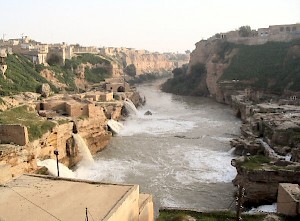Pasitigris (Karun)
Q461557Pasitigris: river in ancient Elam, modern Karun.

The river Karun or, to use its ancient name, the Pasitigris, rises in the Zagros mountains and passes through Khuzestan (ancient Elam) until it joins the Shatt al-Arab (or Arvand Rud) near modern Khoramshahr. It becomes navigable for large vessels near modern Ahvaz. The Greek author Diodorus describes the river:
This flows down from the mountains of the Uxii and passes at first for a thousand furlongs [175 km] through rough country broken by great gorges, but then traverses a level plain and becomes ever quieter, and after six hundred furlongs [105 km] empties into the Persian sea. Alexander crossed this stream and entered the country of the Uxii, which was rich, watered by numerous streams, and productive of many fruits of all kinds. At the season when the ripe fruit is dried, the merchants who sail on the Pasitigris are able to bring down to Babylonia all sorts of confections good for the pleasures of the table.note

It is known that in the fourth century BCE, the Pasitigris emptied itself directly in the Persian Gulf near a town that was founded by Alexander the Great, Alexandria in Susiana. In fact, it is not exaggerated to state that the alluvial plain of Khuzestan consists solely of sediments of the rivers Karun, Dez, and Karkheh, which are brought down whent the snow in the Zagros melts in the spring. But although the river has sometimes changed its course, Diodorus' estimates of the river's length are too low. At the moment, the river has a length of about 740 kilometer.

North of Ahvaz, the river can only be used by shallow vessels. Beyond Shushtar, however, waterfalls make the river useless for even this type of river transport. At this point, there used to be a bridge, built by Roman POWs working for the Sasanian king Shapur I, after 260 CE. The remains are still visible.
Swimming in the Karun is not without danger, because sharks are known to come far upstream.
 Karun, upper reaches (along the road from Yasuj to Isfahan) |